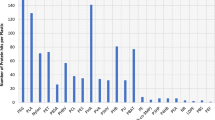Abstract
Recently, a unique archaeal/bacterial community that grows in a macroscopically visible string-of-pearls-like structure in cold (~10 °C), sulfurous marsh water was discovered. Here, a new technique is described that allows the fast and reliable growth of these string-of-pearls-like microbial communities in larger quantities on polyethylene nets in nature. The microbial net population, estimated to consist of about 10,000 single pearls, can be harvested once a week and the archaeal cells selectively separated by density gradient centrifugation. As in native pearls, the archaeal cell fraction obtained consisted of a single type of coccoid cells only, 0.6 µm in diameter. This novel type of euryarchaea has been tentatively named SM1 euryarchaeon. Electron microscopy and immuno-fluorescence in situ hybridization (immuno-FISH) revealed that about 100 pili-like fibers, up to 3 µm in length, emanate radially from the surface of each cell. The SM1 euryarchaeal cells exhibited a viability of about 90%. The optimal conditions for viability were temperatures between −2 °C and 20 °C, pH 5–9, and low salt conditions; cell viability was independent of oxygen partial pressures. The cultures stained gram-positive, the cell wall was sensitive to SDS, EDTA and Proteinase K treatment. The cells did not exhibit the typical fluorescence for methanogens and did not contain coenzyme F420. The G+C-content was 34.5 mol%.



Similar content being viewed by others
References
Amann RI, Binder BJ, Olson RJ, Chisholm SW, Devereux R, Stahl DA (1990) Combination of 16S rRNA-targeted oligonucleotide probes with flow cytometry for analyzing mixed microbial populations. Appl Environ Microbiol 56:1919–1925
Amann RI, Ludwig W, Schleifer KH (1995) Phylogenetic identification and in situ detection of individual microbial cells without cultivation. Microbiol Rev 59:143–169
Antunes A, Eder W, Fareleira P, Santos H, Huber R (2003) Salinisphaera shabanensis gen. nov., sp. nov., a novel, moderately halophilic bacterium from the brine-seawater interface of the Shaban Deep, Red Sea. Extremophiles 7:29–34
Aßmus B, Schloter M, Kirchhof G, Hutzler P, Hartmann A (1997) Improved in situ tracking of rhizosphere bacteria using dual staining with fluorescence-labeled antibodies and rRNA targeted oligonucleotides. Microb Ecol 33:32–40
Baumeister W, Steven AC (2000) Macromolecular electron microscopy in the era of structural genomics. TIBS 25:624–631
Bridger JM, Lichter P (1999) Analysis of mammalian interphase chromosomes by FISH and immunofluorescence. In: Bickmore WA (ed) Chromosome structural analysis, Oxford University Press, New York, pp 103–121
Brock TD (1967) Life at high temperatures. Science 158:1012–1019
DeLong EF (1992) Archaea in coastal marine environments. Proc Natl Acad Sci USA 89:5685–5689
Eder W, Ludwig W, Huber R (1999) Novel 16S rRNA gene sequences retrieved from highly saline brine sediments of Kebrit Deep, Red Sea. Arch Microbiol 172:213–218
Fuhrman JA, McCallum K, Davis AA (1992) Novel major archaebacterial group from marine plankton. Nature 356:148–149
Grimm R, Singh H, Rachel R, Typke D, Zillig W, Baumeister W (1998) Electron tomography of ice-embedded prokaryotic cells. Biophys J 74:1031–1042
Huber H, Hohn MJ, Rachel R, Fuchs T, Wimmer VC, Stetter KO (2002) A new phylum of Archaea represented by a nanosized hyperthermophilic symbiont. Nature 417:63–67
Huber R, Woese CR, Langworthy TA, Kristjansson JK, Stetter KO (1990) Fervidobacterium islandicum sp. nov., a new extremely thermophilic eubacterium belonging to the "Thermotogales". Arch Microbiol 154:105–111
Imhof M, Schlötterer C (2001) Fitness effects of advantageous mutations in evolving Escherichia coli populations. Proc Natl Acad Sci USA 98:1113–1117
Leadbetter JR, Breznak JA (1996) Physiological ecology of Methanobrevibacter cuticularis sp. nov. and Methanobrevibacter curvatus sp. nov. isolated from the hindgut of the termite Reticulitermes flavipes. Appl Environ Microbiol 62:3620–3631
Moissl C, Rudolph C, Huber R (2002) Natural communities of novel archaea and bacteria with a string-of-pearls like morphology: molecular analysis of the bacterial partners. Appl Environ Microbiol 68:933–937
Morita RY (1975) Psychrophilic bacteria. Bact Rev 39:144–167
Nickell S, Hegerl R, Baumeister W, Rachel R (2003) Pyrodictium cannulae enter the periplasmic space but do not enter the cytoplasm, as revealed by cryo-electron tomography. J Struct Biol 141:34–42
Olsen GJ, Lane DJ, Giovannoni SJ, Pace NR, Stahl DA (1986) Microbial ecology and evolution: a ribosomal RNA approach. Annu Rev Microbiol 40:337–365
Pace NR, Stahl DA, Lane DJ, Olsen GJ (1986) The analysis of natural microbial populations by ribosomal RNA sequences. Adv Microbiol Ecol 9:1–55
Papadopoulos D, Schneider D, Meier-Eiss J, Arber W, Lenski RE, Blot M (1999) Genomic evolution during a 10,000-generation experiment with bacteria. Proc Natl Acad Sci USA 96:3807–3812
Rudolph C, Wanner G, Huber R (2001) Natural communities of novel archaea and bacteria growing in cold sulfurous springs with a string-of-pearls like morphology. Appl Environ Microbiol 67:2336–2344
Schönheit P, Keweloh H, Thauer RK (1981) Factor F420 degradation in Methanobacterium thermoautotrophicum during exposure to oxygen. FEMS Microbiol Lett 12:347–349
Stahl DA, Amann R (1991) Development and application of nucleic acid probes. In: Stackebrandt E, Goodfellow M (eds) Nucleic acid techniques in bacterial systematics, Wile, Chichester, pp 205–248
Stetter KO (1999) Extremophiles and their adaption to hot environments. FEBS Lett 452:22–25
Watnick P, Kolter R (2000) Biofilm, city of microbes. J Bacteriol 182:2675–2679
Woese CR, Kandler O, Wheelis ML (1990) Towards a natural system of organisms: Proposal for the domains Archaea, Bacteria and Eucarya. Proc Natl Acad Sci USA 87:4576–4579
Acknowledgements
We are grateful to Karl Otto Stetter for advice and stimulating discussions. Furthermore, we thank Ruth Henneberger for providing data and Brian Hedlund for critically reading the manuscript. We are indebted to the Government of Bavaria (Germany) for a sampling permit. Financial support from the Deutsche Forschungsgemeinschaft (Hur 711/2) is gratefully acknowledged.
Author information
Authors and Affiliations
Corresponding author
Rights and permissions
About this article
Cite this article
Moissl, C., Rudolph, C., Rachel, R. et al. In situ growth of the novel SM1 euryarchaeon from a string-of-pearls-like microbial community in its cold biotope, its physical separation and insights into its structure and physiology. Arch Microbiol 180, 211–217 (2003). https://doi.org/10.1007/s00203-003-0580-1
Received:
Revised:
Accepted:
Published:
Issue Date:
DOI: https://doi.org/10.1007/s00203-003-0580-1




